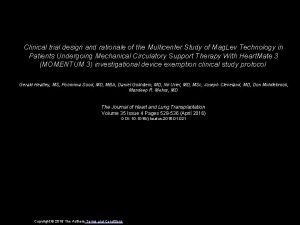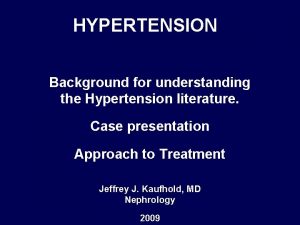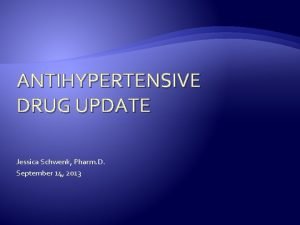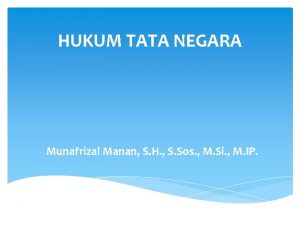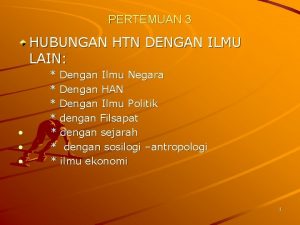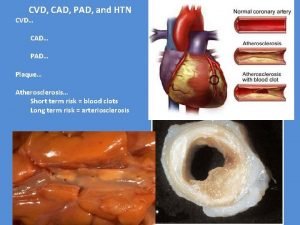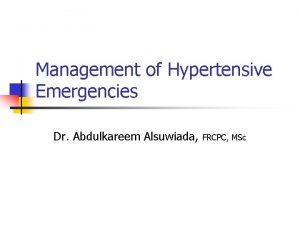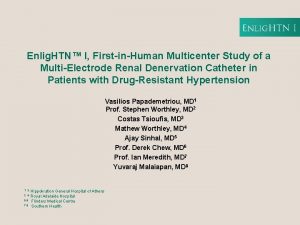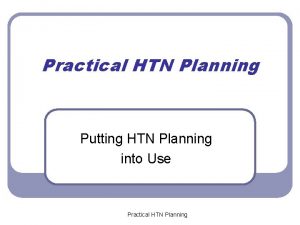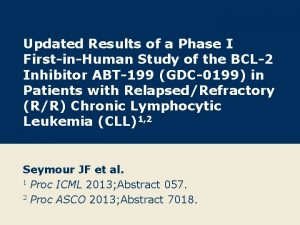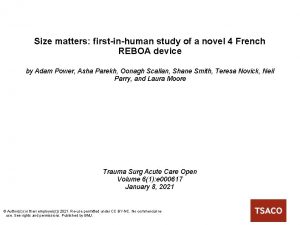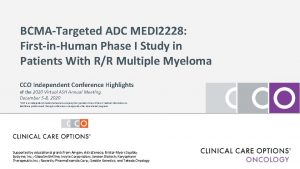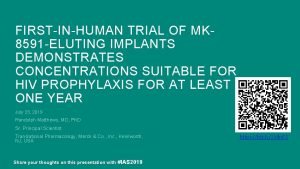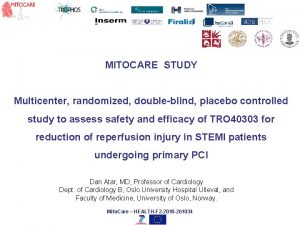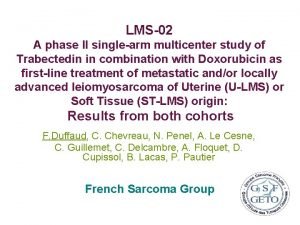Enlig HTN I FirstinHuman Multicenter Study of a















- Slides: 15

Enlig. HTN™ I, First-in-Human Multicenter Study of a Multi-Electrode Renal Denervation Catheter in Patients with Drug-Resistant Hypertension Vasilios Papademetriou, MD 1 Prof. Stephen Worthley, MD 2 Costas Tsioufis, MD 3 Mathew Worthley, MD 4 Ajay Sinhal, MD 5 Prof. Derek Chew, MD 6 Prof. Ian Meredith, MD 7 Yuvaraj Malaiapan, MD 8 1, 3. Hippokration General Hospital of Athens Adelaide Hospital Flinders Medical Centre Southern Health 2, 4. Royal 5, 6. 7, 8.

Enlig. HTN I: Background / Study Objectives Background § Renal denervation has emerged as a treatment for patients with drugresistant hypertension § Single-tip electrode radiofrequency ablation catheters have been used to achieve sympathetic fiber interruption through the renal artery wall § However, systems designed to create predetermined predictable ablation pattern have not been tested § Ideal lesions are transmural, causing fiber interruption, but no scar or charring Study Objectives § To investigate the safety and efficacy of a multi-electrode catheter ablation system (Enlig. HTN) in patients with drugresistant hypertension § Primary Safety Marker: All adverse events § Primary Efficacy Marker: Change in office BP at 6 months § Additional Endpoints Assessment Over Time: § Renal artery evaluation § Renal function § Home based BP § 24 hr. ambulatory BP § Anti-hypertensive medication changes

Enlig. HTN™ Multi-Electrode Renal Denervation System* Generator Ablation Catheter § § § Multi-electrode Radiopaque electrodes 8 F compatible Deflectable, atraumatic tip Femoral access *CE Mark — December 2011 Not for sale in the U. S. §Default settings: § § Power output (6 Watts) Impedance (400Ω) Electrode temperature (75 degrees C) Time (90 seconds per ablation) §Temperature controlled

Renal Procedure Goal: Effective Denervation Transmurality* Acute lesion formation** Predictable Pattern After one month** * Atherton DS, Deep NL, Mendelsohn FO, Micro-Anatomy of the Renal Sympathetic Nervous System: A Human Postmortem Histological Study, Clinical Anatomy 2011. ** Animal study. Results on file at St. Jude Medical

Procedure Overview § Initial basket positioning proximal to the bifurcation § Expand basket and perform generator diagnostic check for electrode contact § Ablate – 90 seconds per electrode § For a second set of ablations the basket is collapsed, pulled back 1 cm, rotated and expanded, contact is checked and ablation sequence repeated

Inclusion / Exclusion Criteria Inclusion Criteria § Patient written informed consent § Willing / able to comply with follow-up schedule § Appropriate renal artery anatomy § Office Systolic BP ≥ 160 mm. Hg § Stable use of ≥ 3 antihypertensive medications concurrently at maximally tolerated doses for a minimum of 14 days prior to enrollment of which: § one is a diuretic, or § patient was on diuretic previously but documented to be diuretic intolerant § ≥ 18 and ≤ 80 years old Exclusion Criteria § Prior renal artery intervention or evidence of renal artery disease (diameter stenosis >30%) § Multiple main renal arteries in either kidney or main renal arteries <4 mm in diameter or <20 mm in length § e. GFR of <45 m. L/min/1. 73 m 2 (MDRD formula) § Type 1 Diabetes Mellitus or identified secondary cause of hypertension § Hemodynamically significant valvular heart disease

Study Design * Exclusion due to renal artery anatomy therefore renal denervation was not attempted.

Baseline Characteristics n = 46* Gender (female) 15 (33%) Ethnic origin (white) 45 (98%) Body Mass Index (kg/m 2) 32 (± 5) Coronary Artery Disease 9 (20%) Hyperlipidemia 27 (59%) Type II Diabetes Mellitus 15 (33%) Sleep Apnea 14 (30%) e. GFR (m. L/min/1. 73 m 2) 87 (± 19) Serum Creatinine (mmol/L) 78 (± 17) Cystatin C (mg/L) Number of Anti-Hypertensive Medications Office Systolic Blood Pressure (mm. Hg) 1. 14 (± 0. 29) 4. 1 (± 0. 6) 176 (± 16) Office Diastolic Blood Pressure (mm. Hg) 96 (± 14) Heart Rate (bpm) 71 (± 12) • Two patients did not meet all inclusion criteria, but are included in the analyses • Data are mean (±SD) or number (%)

Results: Safety Data The primary safety outcome was assessment of all adverse events § Serious Peri-Procedural Events: NONE § No renal artery dissections, aneurysms or new stenosis § No flow-limiting renal artery vasospasms § No major vascular access complications § Non-Serious Peri-Procedural Events: § Non-flow limiting vasospasms, puncture site hematomas, vasovagal reactions, low back pain, hypotensive episodes, transient hematuria, nausea and bradycardia § Serious device/procedure events include: § Worsening of pre-existing proteinuria (n=1) § Symptomatic hypotension (n=1) § Worsening of pre-existing renal artery stenosis (n=1) The Enlig. HTN System delivers renal denervation with an acceptable safety profile through 6 months

Renal Function § There was no clinically significant change in renal function § No patient experienced: § a reduction in e. GFR >50%, § a two-fold increase in Serum Creatinine, or § progressed to end stage renal disease § Laboratory Values: e. GFR (m. L/min/1. 73 m 2) Serum Creatinine (mmol/L) Cystatin C (mg/L) Baseline (n=46) Month 1 (n=46) Month 3 (n=46) Month 6 (n=45) 87 (± 19) 85 (± 20) 84 (± 22) 82 (± 20) 78 (± 17) 79 (± 19) 81 (± 20) 83 ± (20) 1. 14 (± 0. 29) 1. 00 (± 0. 25) 0. 97 (± 0. 20) 1. 00 (± 0. 23)

Mean Office Blood Pressure

Office BP Reduction from Baseline p <0. 0001 Enlig. HTN therapy delivers a rapid and significant reduction in Office BP that is sustained through the 6 M timeframe

24 hr Ambulatory BP Reduction from Baseline P values are <0. 0001, except Diastolic 1 mo p-value 0. 0003 Diastolic 3 mo p-value 0. 0002 Enlig. HTN therapy delivers a rapid and significant reduction in Ambulatory BP that is sustained through the 6 M timeframe

Responder & Goal Blood Pressure Parameters § % Responders (>10 mm. Hg Reduction from baseline) = 76% (n=34) § At Goal SBP: 2/3 of patients will have a great enough reduction in their BP to move to a lower stage of HTN classification / treatment and approximately 1/3 of patients treated with Enlig. HTN no longer meet HTN classification

Conclusions Safe § No renal artery dissections, aneurysms, or new stenoses § No flow-limiting renal artery vasospasms § No major vascular access complications Rapid Treatment Effect § Office BP was reduced by 28/10 mm. Hg at 1 month Sustained Results § Office and Ambulatory BP results were concordant and sustained at 6 months § 76% of patients were responders at 6 months The Enlig. HTN™ system delivers a promising therapy for the treatment of patients with resistant hypertension
 Multicenter study design
Multicenter study design Rbk fuktmätning
Rbk fuktmätning Htn emergency vs urgency
Htn emergency vs urgency Malignant hypertension treatment
Malignant hypertension treatment Htn urgency vs emergency
Htn urgency vs emergency Htn statis dan dinamis
Htn statis dan dinamis Hubungan htn dengan ilmu lainnya
Hubungan htn dengan ilmu lainnya Cad htn
Cad htn Htn emergency vs urgency
Htn emergency vs urgency Htn vs goap
Htn vs goap Ecological study vs cohort study
Ecological study vs cohort study Distinguish between motion study and time study
Distinguish between motion study and time study Phytogeographical regions of india by d chatterjee
Phytogeographical regions of india by d chatterjee Retrospective cohort study vs prospective cohort study
Retrospective cohort study vs prospective cohort study Distinguish between time study and motion study
Distinguish between time study and motion study Work study technique
Work study technique
